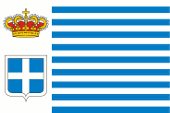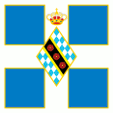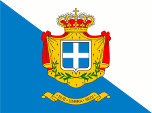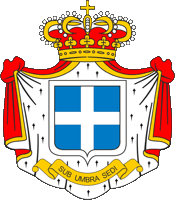Seborga |
|
|
|
| Übersicht – Contents: | |
Diese Seite ist Teil des Projektes
Seborga |
|
|
|
| Übersicht – Contents: | |
Flaggen – Flags: |
|
 |
National- und Staatsflagge |
 |
seit/since 2019, |
historische Flaggen – historical Flags: |
|
 |
12. Jhd./cent. – 1729, |
 |
1995–1997, |
 |
1997–2019, |
| Die Flagge von Seborga zeigt achtzehn Streifen in Weiß und Blau und am Mast ein weißes Feld mit einem weiß umrandeten blauen Wappen mit einem weißen gleicharmigen Kreuz. Darüber eine goldene Krone. Die Farben sind wahrscheinlich historisch, denn Seborga soll bis 1729 eine weiß-blaue, diagonal geteilte Flagge gezeigt haben. Offenbar nimmt die Gestaltung der Flagge auch Bezug auf zwei lokal bedeutende Wappen. Das Wappen der "Ritter von San Monardo" und das "Wappen der Ritter von der Corona" (siehe unten). | The flag of Seborga shows eighteen stripes in white and blue and at the pole a white field with an white bordered blue coat of arms with a white isosceles cross. Above that a golden crown. The colours are probably historical because Seborga should have used until 1729 a white-blue diagonally divided flag. Obviously is the designing of the flag derived from two locally important Coat of arms. The scutcheon of the "Knights of San Monardo" and the scutcheon of the "Knights of the Corona" (look below). |
| Quelle/Source: Volker Preuß | |
| Wappen – Coat of arms: | |
 |
Wappen des Fürstentums Seborga – coat of arms of the Principality of Seborga, Quelle/Source, nach/by: www.principatodiseborga.com |
 |
Wappen der Ortschaft Seborga – coat of arms of the village of Seborga, Quelle/Source, nach/by: Wikipedia (DE) |
 |
Wappen der Ritter von San Monardo – coat of arms of the Knights of San Monardo, Quelle/Source, nach/by: uchterhous.org |
 |
Wappen der Ritter der Corona – coat of arms of the Knights of the Corona, Quelle/Source, nach/by: uchterhous.org |
| Das Wappen des Fürstentums Seborga zeigt ein weißes Kreuz auf einem weiß umrandeten blauen Schild. Unterhalb des Schildes ein goldenes Spruchband mit dem Motto des Fürstentums: "sub umbra sedi" → "Ich sitze im Schatten" Das Wappen liegt auf einem roten Wappenmantel, der innen mit Hermelin belegt ist. Darüber eine goldene Krone. | The coat
of arms of the Principality of Seborga shows a white cross on a white
bordered blue shield. Below the shield a golden banner with the motto of the principality: "sub umbra sedi" → "I sit in the shadow" The coat of arms is placed on a red scutcheon-coat which is decorate inside with ermine. Above it a golden crown. |
| Die Farben des Wappens sind möglicherweise historisch, denn Seborga soll bis 1729 eine weiß-blaue, diagonal geteilte Flagge gezeigt haben. Welchen heraldischen Ursprung das gleicharmige Kreuz hat ist nicht bekannt. Die Farbe Blau könnte auf die Zisterzienser zurückgehen. | The
colours of the coat of arms are possibly historic, because Seborga should
have used until 1729 a white-blue diagonally divided flag. The heraldic origin of the isosceles cross is not known. The colour blue could got back to the Sacer Ordo Cisterciensis. |
| Von großer Bedeutung sind zwei lokale Wappen. Das Wappen der "Ritter von San Monardo" und das Wappen der "Ritter von der Corona". Dabei handelt es sich wahrscheinlich um Strukturen innerhalb der Seborghesen, die sich als Nachfahren der Kreuzritter des Mittelalters sehen, welche einst diesen Staat gründeten. So zeigt das Wappen der "Ritter von San Monardo" siebzehn horizontale Streifen. Ein deutlicher Hinweis auf die siebzehn Familien, aus denen sich die ca. 360 Seborhgesen zusammensetzen. Das Wappen der "Ritter von der Corona" zeigt die Farben Weiß und Blau auf einem diagonal geteilten Schild, ein blaues Kreuz und vier goldene Lilien. Die Farbe Blau und auch die Lilien könnten auf die Zisterzienser zurückgehen. | Two local coats of arms are from a great importance. The scutcheon of the "Knights of San Monardo" and the scutcheon of the "Knights from the Corona". These are probably structures within the Seborghese – which see itself as the descendants of the crusaders in the middle ages – which once established this state. In this way the coat of arms of the "Knights of San Monardo" shows seventeen horizontal stripes. A clear indication for the seventeen families which the ca. 360 Seborhgese consist of. The coat of arms of the "Knights from the Corona" shows the colours white and blue on a diagonally divided shield, a blue cross and four golden lilies. The color blue and as well the lilies could have their roots in the Sacer Ordo Cisterciensis. |
| Das Wappen der Ortschaft Seborga zeigt ein rotes Schild mit einer weißen Mitra, einem grünen Krummstab und zwei grüne Palmwedel. | The coat
of arms of the place of Seborga shows a red shield with a white miter, a
green curved baton and two green palm tree twigs. |
| Quelle/Source: Volker Preuß | |
| Zahlen und Fakten – Numbers and Facts: | |
|
|
|
|
|
|
|
|
|
|
|
|
|
|
|
|
| frühes
Mittelalter · Seborga ist ein Lehen der Grafen von Ventimiglia 954 · Graf Guido übergibt die Burg an die Benediktinerabtei Lérins 1079 · Fürstentum im Heiligen Römischen Reich Deutscher Nation mit Investitur des Fürstabtes durch Papst Gregor VII. 1118 · Fürstabt Eduard – inzwischen ein Abt der Zisterzienser – ernennt die ersten neun Tempelritter (dies war ein weltlicher Staatsakt, mit dem de fakto ein Zisterzienser kraft seiner kirchlichen und weltlichen Macht als Fürstabt seine Abtei in einen Feudalstaat wandelt) 1127 · Rückkehr der Tempelritter aus der Levante, Bernhard von Clairvaux weiht Hugo von Paynes zum ersten Großmeister des Templerordens, Ritter des Templerordens werden als Fürsten auf Lebenszeit von den Rittern gewählt 1666 · Seborga prägt eigene Münzen (Luigino) 1729 · das Zisterzienser-Fürstentum Seborga wird an Vittorio Amedeo II., Fürst von Piemont, Herzog von Savoyen und König von Sardinien verkauft, jedoch wird der Kauf nicht registriert und nie bezahlt 1748 · Friede von Aachen, Seborga wird nicht in die Republik Genua eingegliedert 1815 · Wiener Kongress, Seborga wird nicht in das Königreich Sardinien eingegliedert 1861 · Gründung des Königreichs Italien, Seborga wird in der Gründungsakte nicht erwähnt 1934 · Anerkennung der Exterritorialität durch den italienischen Regierungschef Benito Mussolini 1946 · Gründung der Republik Italien, Seborga wird in der Gründungsakte nicht erwähnt 1963 · die Seborghesen (Nachfahren der Kreuzritter in Seborga), nehmen die Tradition wieder auf und wählen Giorgio Carbone zum Fürsten Giorgio I. 23.04.1995 · in einer Volksabstimmung befürworten die Seborghesen mit 98% die neue Verfassung und somit die Unabhängigkeit des Fürstentums Seborga 24.04.1995 · Wiedereinführung der Währung Luigino 2009 · Tod von Fürst Giorgio I. 2010 · gewählter Nachfolger wird Fürst Marcello I. 2019 · gewählter Nachfolger von Marcello I. wird Fürstin Nina |
| early
middle ages · Seborga is a fiefdom of the Counts of Ventimiglia 954 · Count Guido hands over the castle to the Benedictinian abbey of Lérins 1079 · principality in the Holy Roman Empire of German Nation with investiture of the prince-abbot by Pope Gregor VII. 1118 · Prince-Abbot Edouard – meanwhile an abbot of the Sacer Ordo Cisterciensis – nominates the first nine temple-knights (this was a secular state act, with that a Cisterciense de facto converts with its clerical and secular power as prince-abbot its abbey into a feudal state). 1127 · return of the temple-knights from the Levante, Bernhard of Clairvaux hallows Hugo of Paynes to the first High Master of the Templars Order, knights of the Templars Order become elected by the knights as princes in livetime 1666 · Seborga coins own coinage (Luigino) 1729 · the Cisterciense-Principality of Seborga becomes selled to Vittorio Amedeo II., Prince of Piemont, Duke of Savoyen and King of Sardinia, but the purchase was never registered and was never payed 1748 · Peace of Aachen, Seborga becomes not incorporated into the Republic of Genova 1815 · Vienna Congress, Seborga becomes not incorporated into the Kingdom of Sardinia 1861 · foundation of the Kingdom of Italy, Seborga is not mentioned in the founding file 1934 · recognition of the exterritoriality by the Italian chief of government Benito Mussolini 1946 · foundation of the Republic of Italy, Seborga is not mentioned in the founding file 1963 · the Seborghese (descendants of the crusaders in Seborga), maintain the tradition and elect Giorgio Carbone to the Prince Giorgio I. 23rd of April 1995 · in a referendum the Seborghese support with 98% the new constitution and in this way the independence of the Principality of Seborga 24th of April 1995 · re-introduction of the Luigino currency 2009 · death of Prince Giorgio I. 2010 · elected successor is Prince Marcello I. 2019 · elected successor of Marcello I. is Princess Nina |
| Quelle/Source: World Statesmen, Wikipedia (EN) |
| Der Name Seborga geht auf den römischen Namen "Castrum Sepulcri" (Grabesburg) zurück. Daraus wurde später "Sepulcri Burgum" und noch später "Seporca" und schließlich "Seborga". | The name Seborga has its roots in the Roman name "Castrum Sepulcri" (grave's castle). That became later "Sepulcri Burgum" and even later "Seporca" and finally "Seborga". |
| Die ursprünglichen Einwohner von Seborga nennen sich "Seborghesen". Es handelt sich um siebzehn Familien (ein Teil der Gesamtbevölkerung), die sich als Nachfahren der Kreuzritter des Mittelalters sehen, welche einst diesen Staat gründeten. Die übrige Bevölkerung sind Italiener, Franzosen und Deutsche, die auf dem Staatsgebiet leben, sind jedoch keine Seborghesen, und haben in Seborga kein Stimmrecht. | The
pristine inhabitants of Seborga name itself "Seborghese". These are
seventeen families (a part of the total population), which see
itself as the descendants of the crusaders in the
middle ages, which once established that state. The other population are Italians, Frenchmen and Germans which live on the territory of the state, but they are none Seborghese and have in Seborga no right to vote. |
|
|
| Quelle/Source: Wikipedia (DE), www.seborga.homeip.net | |
|
|
|
Mit freundlicher Untersützung von: Kindly supported by: |
E. Hoheisel (D) |